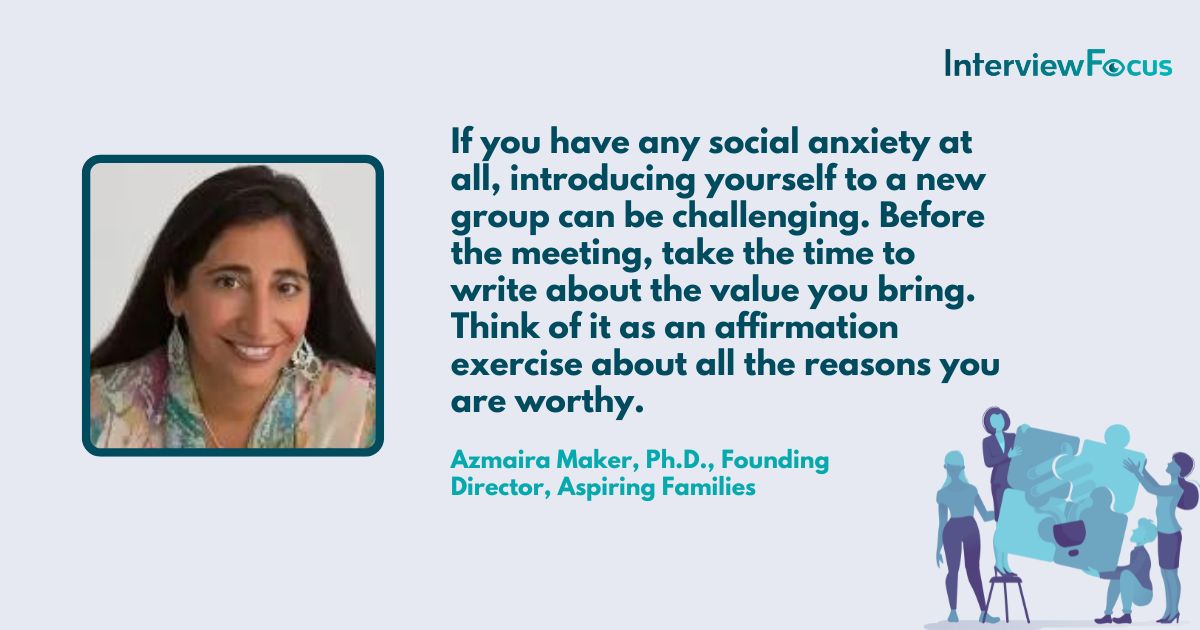From showing courage by volunteering to drawing specific connections between personal qualities and professional successes, here are 10 answers to the question, “What are tips for introducing yourself in a group interview?”
- Go First Or Last, Avoid the Middle if Possible
- Express Yourself
- Practice Affirmations
- Don’t Tune Out While Waiting for Your Turn to Speak
- Mirror the Energy of the Interviewer
- Use the “Who, Why, Where” Response Format
- Form a Connection With Each Interviewer
- Be Confident and Concise
- Introduce Yourself With a Smile
- Prepare an Engaging Elevator Pitch About Skills
Go First or Last, Avoid the Middle if Possible
There’s been a lot of research into this phenomenon, but it really seems like going first or last makes you much more memorable in group introduction settings than going in the middle.
In my experience, this also makes a great deal of sense, as the person going first shows a lot of courage volunteering, and going last lets you more easily stick out in the mind.
I always say going first is best—you get to set the tone of the introductions and not have to worry about conforming to how others have gone before you.
Dragos Badea, CEO, Yarooms
Express Yourself
For example, smile, use your hands, etc., to show some sort of expression. Doing so helps you stand out among the group and be a memorable face from the crowd. You don’t always get your chance to stand out in group interviews, so using facial expressions or other body languages can be your best bet.
Bradley Hall, Co-Founder and CEO, SONU Sleep
Practice Affirmations
If you have any social anxiety at all, introducing yourself to a new group can be challenging. Before the meeting, take the time to write about the value you bring. Think of it as an affirmation exercise about all the reasons you are worthy.
Then, take a deep breath and walk into that group with your head held high. As the interaction progresses, any time you feel doubt, remind yourself of your affirmations.
Azmaira Maker, Ph.D., Founding Director, Aspiring Families

Don’t Tune Out While Waiting for Your Turn to Speak
My name is Rob Reeves, and I’m the CEO and President of Redfish Technology, a recruiting firm specializing in engineering, sales, and marketing roles within the tech sector. As a recruiter, I’ve prepared a lot of workers for group interviews. My top tip? Engage in active listening when it’s not your turn to talk.
Your primary focus should be on the interviewer, but don’t tune out while others introduce themselves. If you can’t recall a single name mentioned before yours, you will not come across as someone who is engaged and able to multitask.
So find a trick that helps you solidify the names and faces of your competitors. One thing that typically helps is finding a correlation between a person’s appearance and their name to create a visual linkage in your mind.
Rob Reeves, CEO and President, Redfish Technology
Mirror the Energy of the Interviewer
The number one thing is that there is no silver bullet answer here. It depends on what room you’re walking into and who’s in that room. An interview situation is like a game of tennis. I match the energy of who I’m speaking to and mirror it back to the interviewer.
For panels and group interviews, I would let the interviewer guide the tone and flow of the discussion. I would let them go first, and when it’s my turn, be direct and concise. Some good talking points are who I am, why I’m here, and why I’m an excellent fit for the specific role.
Don’t give away too much information in the introduction. That’s a good sign that I’m talking too much and might keep the audience and hiring manager from taking an interest in me. Try to remain calm and convey that I’m confident. Make sure I stand out without being too risky.
Oz Rashid, Founder and CEO, MSH
Use the “Who, Why, Where” Response Format
As any seasoned interviewer will tell you, first impressions matter. Your initial introduction will set the tone for the interview, and a poor first impression can be difficult to bounce back from. To avoid stumbling, rambling, or going off on a tangent, I recommend sticking to the “Who,” “Why,” and “Where” response format:
Who: Briefly explain who you are, what your background is, and what makes you a unique individual.
Why: Outline why you have applied to work here, what attracted you to the company, and why you feel you are a good fit.
Where: Outline where you want to be in the future, what your career goals are, and what you envision yourself doing several years from now.
These three prompts give interviewers and fellow interviewees all the information they need, adding a much-needed structure to an otherwise amorphous introduction process.
Ben Schwencke, Business Psychologist, Test Partnership
Form a Connection With Each Interviewer
Leverage what you know about the interviewers by tailoring your introduction to their interests, experiences, or values. To do this successfully, you need to research the interviewers’ backgrounds, work experiences, and interests before the interview.
You can check their LinkedIn profiles or read their bios on the company website. This information can help you understand what they might look for in a candidate and what topics they may be interested in.
Use these insights to develop a rapport with the interviewers. For instance, if you share something in common with an interviewer, such as having attended the same university, mention it during your introduction. If you know an interviewer who is interested in project management, you can highlight your experience leading a team to complete a project as part of your introduction.
This approach helps you develop a genuine connection with one or more of the interviewers, increasing your likelihood of success in the interview.
Lilia Koss, Community Manager, Facialteam
Be Confident and Concise
Do your best to be confident and concise. They chose you for a reason. Start by greeting the group and thanking them for the opportunity to interview. Then, briefly introduce yourself by sharing your name, your background, and any relevant experience or skills that make you a good fit for the position.
Be sure to maintain eye contact, speak clearly and confidently, and avoid rambling or going off-topic. This will help you create a good initial impression and show off your preparedness and professionalism.
Kelli Anderson, Career Coach, ResumeSeed

Introduce Yourself With a Smile
Make sure you look people in the eye when you introduce yourself and keep a positive attitude. It’s also important to be confident and express yourself clearly and concisely. Let the interviewer know why you’re excited to be there, and why you’re the best person for the job.
Amy Lee, Medical Advisor, Nucific
Prepare an Engaging Elevator Pitch About Skills
An elevator pitch is a brief story about yourself that you can use to explain why you would be suitable for the position. It should be concise, engaging, and descriptive of your abilities; perhaps around 20-30 seconds long.
In particular, focus on how the skills that make you uniquely qualified for the role relate to your experiences. The key to success here is a confident delivery and being able to draw specific connections between personal qualities and professional successes—this will differentiate you from other contenders in a crowded market.
Julia Kelly, Managing Partner, Rigits






